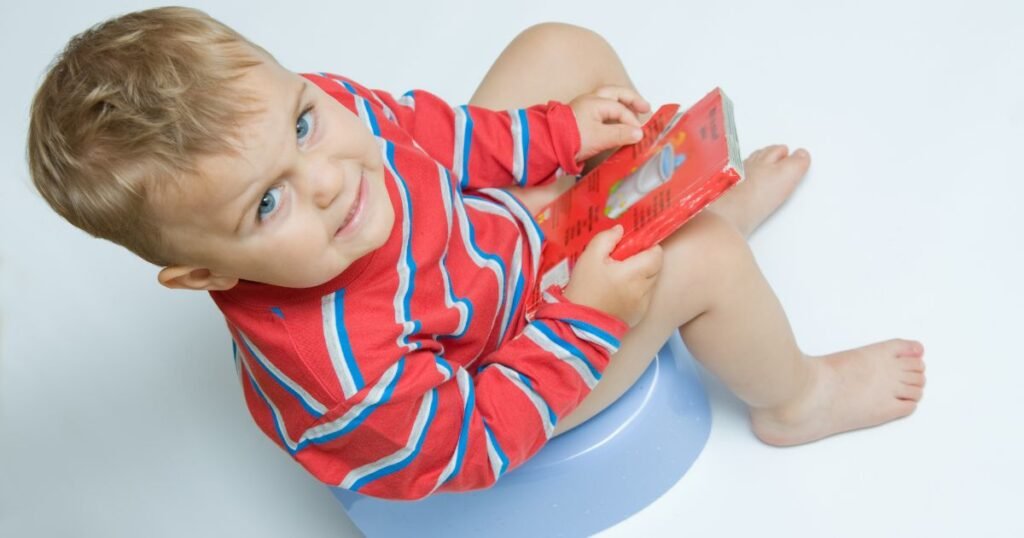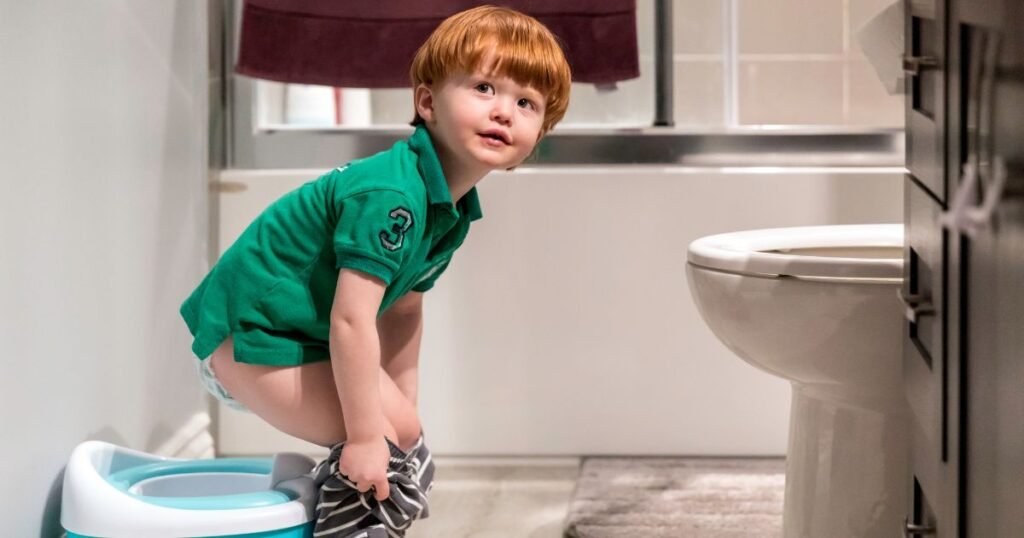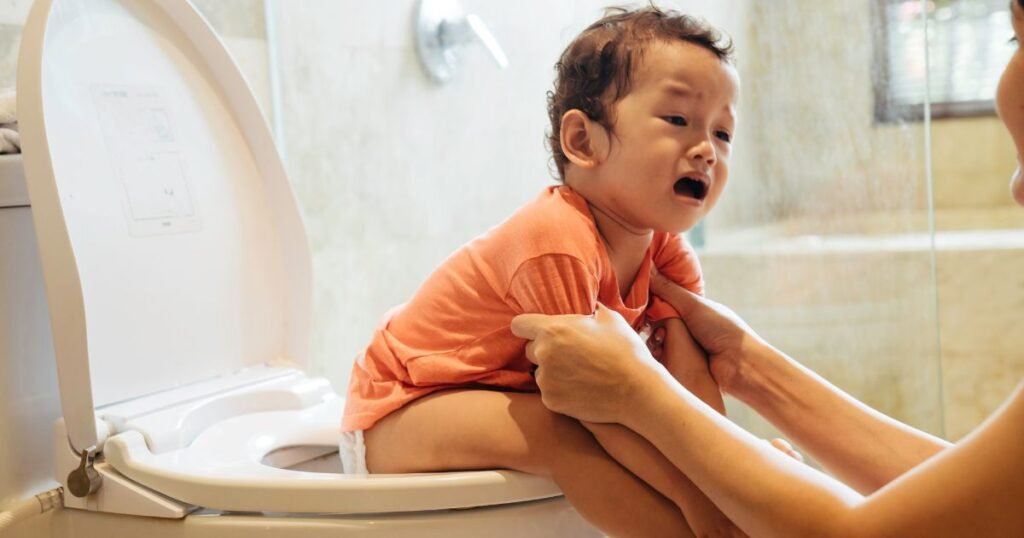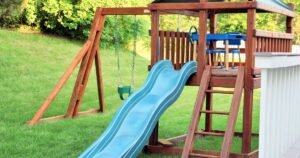Last Updated on 28 June 2024
Teaching your kid to use the potty can be tough, and knowing when to give up on potty training is important. It is all about spotting when your child is ready for potty training and being aware of the signs that it might be time to either start or call it quits for a while. Running into problems like accidents or your child not wanting to try is common, but there are ways around these issues. If you notice things aren’t getting better, they’re losing interest, or if trying turns into crying and fights over using the potty, it might be wise to pause and switch things up.
Experts say sticking with it matters, but so does being willing to try new methods, such as using pull-ups, to help your child learn. Remember that every kid is different, and this journey of teaching them about going potty should happen at their own pace with lots of patience and understanding from you. Teaching a child how to use the potty can be hard and sometimes annoying for both kids and their parents. It takes patience, consistency, and trying different things until something works. But figuring out when it might be best to take a break from potty training is just as crucial as deciding when to start.
Are you having a tough time teaching your kid to use the potty? Are you wondering if it’s better to throw in the towel or keep going? In this article, we will cover all you need to know about potty training and offer expert advice on when it could be wise to pause or stop trying, especially if your child has shown signs of regression in the last month. Whether you’re just starting with potty training or have been attempting it for some time now, I will give you helpful tips and directions on tackling this big step in growing up.
Understanding the Potty Training Process
Potty training is all about helping your kid learn to use the toilet instead of wearing diapers. It usually starts when they are between two and three years old and show signs that they are ready for it. Through this journey, parents have a few tasks: explaining how the potty works, teaching their child to notice when it’s time to go, and guiding them until they can manage independently.
The Right Age to Begin Potty Training
When it comes to potty training, every kid has no universal right time. Kids are all over the map in terms of when they are ready. But generally speaking, somewhere between 2 and 3 years old is a good ballpark to start thinking about it. Around then, many kids start getting better at noticing what their bodies need and might even get curious about using the toilet or being able to tell you when they need to go—knowing when your kid is ready for potty training matters if you want it to go well. Even though there are some usual signs and tips to watch out for, remember that every child is different and might show they are ready in their way.
A few common things to look out for include showing interest in the toilet, being able to tell you when they need something, and not wetting themselves for a good amount of time, including during naps. But don’t forget who your child is as an individual; their mood and personality also play a big part. Some kids might not be into the idea of potty training or could need more time to get it right. Being patient and encouraging during this stage is key; teach them about using the potty only when they seem truly prepared.
Common Challenges in Potty Training
Teaching your kid to use the potty can be tough for you and them. It’s key to get ready for some usual bumps in the road. Having accidents or not wanting to use the potty at all are pretty common issues. When these slip-ups happen, staying calm and being there for your child greatly matters. Sometimes, kids might not want to try using the toilet because it scares them or makes them nervous. Understanding why this happens and working through it can make teaching your child about potty training way easier for both of you.
Accidents and Setbacks During Potty Training
During potty training, it is pretty normal for kids to have accidents. When these slip-ups happen, keeping your cool and being there for them is key because getting mad or upset might make them feel bad about going to the bathroom. Instead of fussing, kindly remind your little one to try using the potty next time and lend a hand with cleaning up. Sometimes, even after getting the hang of it, children can slide backward and start having accidents again, including pee accidents. This backsliding could be due to many things, like changes in their daily lives or new worries. Through all this, staying patient and encouraging is crucial while you keep emphasizing how important it is to use the toilet.
Resistance To Potty Training and How to Handle It
When it comes to potty training, facing resistance is pretty common. Some kids might say no to using the potty, while others could start acting out by not going when needed or hiding away. We must tackle this with a lot of patience and try to understand why they are resisting in the first place. For instance, some kids might fear falling into the toilet, or something unpleasant happened in the past that makes them wary now. By understanding and soothing these fears, we can often see less pushback.
Cheering them on with positive feedback, such as praise or rewards, can encourage a hesitant child to try the potty. A reward chart could also do wonders here! Remembering that each kid is unique means sometimes you have to switch up your approach until you find what clicks for overcoming their hesitation about potty training.
Signs: It Might Be Time to Pause or Stop Potty Training
Understanding when to take a break or halt potty training is crucial. Even though you might feel the urge to keep going, certain signs suggest pausing is better. For instance, if your child isn’t making any progress or seems uninterested, along with showing signs of emotional upset and resistance, it’s time to consider stopping for a while. By tuning into what your child communicates through their behavior and feelings, you can decide when to adjust your strategy. Taking some time off from dealing with poop accidents gives both of you a chance to relax and come back ready for another go at potty training.
Lack of Progress and Interest in Potty Training
When you notice your kid isn’t getting the hang of potty training, like still having accidents or not wanting to use the toilet, it might hint that you should take a break from potty training. It can get pretty annoying for both of you if there’s no improvement, and trying to keep going could end up making everyone feel stressed and bummed out. With kids growing at their speed, it’s key to remember that learning how to use the potty doesn’t happen the same way for every child.

If your little one doesn’t seem ready or interested in making progress with using the potty, pausing for a bit and checking if they’re prepared to continue might do some good. However, it’s important not to make a big deal out of accidents and to reassure your child that it’s a natural part of the learning process.
Emotional Distress and Power Struggles
Taking a break might be a good idea when potty training starts to cause upset feelings or fights. Potty training isn’t always easy for kids and their parents. If your child seems unhappy or doesn’t want to do it, this could mean they’re not quite ready yet, or maybe the way you’re doing it needs some tweaking. Sometimes, tensions can flare up when what parents expect clashes with what kids think should happen. Remembering to stay patient and kind during potty training is key because your child’s feelings should come before any specific goals are met. If it’s making things tough at home, taking a step back from potty training could help everyone feel better in the long run.
Expert Advice on knowing when to give up on potty training
Deciding when to take a break from potty training can be tough for parents. Getting advice from those who know a lot about it is key. Taking cues from your child is what many suggest, meaning you watch how they react and change your method if needed. If your kid seems upset or not into it, stopping for a bit could help determine if they are ready. Also, sticking with it while being willing to try new ways is important if the usual steps aren’t doing the trick in potty training.
Taking a little break is a good idea if your kid seems to be struggling or upset with potty training. Potty training is supposed to make kids feel good about themselves and help them learn something new, not the opposite. If you notice they’re feeling scared or stressed about it, stopping can help them calm down and prepare to try again later. This doesn’t mean you are quitting; instead, you are just taking some time off before giving it another go. We must pay attention to what our kids are telling us without words during this time and put their feelings first before worrying too much about when they will master using the potty.
Balancing Persistence with Flexibility
Regarding potty training, finding the right balance between sticking to your guns and being willing to change tactics is crucial. You must keep things consistent and have a plan, but simultaneously, you must be ready to switch things up based on your kid’s needs. Setting clear expectations and guiding them through the process matters a lot, yet paying attention when they’re trying to tell us something without words is just as key.
If your little one starts acting out or seems upset about it all, maybe it’s time for a pause so you can think about how you have been doing things. Being open-minded about different ways of tackling potty training, including being flexible about using dirty diapers as a tool, could make everything go more smoothly for both of you.
Alternatives to Traditional Potty Training
If the usual methods of potty training aren’t helping your kid, it might be a good idea to look into different processes. Since every kid is different, what helps one might not help another. For instance, with the “bare-bottom” method, kids don’t wear underwear or pants to notice better when they need to go potty. Or there’s “elimination communication,” where you watch for signs that your child needs to use the toilet and then guide them to use it at those times. Learning about these alternative approaches and picking one that fits well with how your child learns and how you like to teach is key.
Gradual Transition Methods
When teaching your kid how to use the potty, taking small steps can help. Instead of switching from diapers straight to underwear in one go, you could first introduce them to what a potty is and let them feel okay about the whole thing. Start with having them sit on it for a little while, even if they don’t do anything. This gets them used to how it feels and the idea of using it with the help of their mommy.

As they start feeling more at ease, you can ask them to take more breaks during the day to try going potty. You might set up a timer or stick with a regular schedule for this, placing them on the toilet at regular intervals. Slowly make these breaks further apart so your child learns how long they can wait before needing to go again.
Throughout this slow move towards using the toilet like big kids do, cheering on any bit of progress is key—even when there’s no actual success in terms of usage—because acknowledging their effort matters loads! Celebrating every tiny win helps keep their spirits high and encourages them to stick with learning something new.
Considering Professional Guidance For Potty Training
If potty training has you at your wit’s end and nothing is working, it might be time to consider getting professional help. Talking to someone who knows what they are doing, like a pediatrician or child psychologist, can make a difference. They have the know-how to look into what your kid needs and develop plans to tackle any particular problems you face.
With their expertise, they can also determine if something else is making potty training harder for your little one. Enrolling in a preschool or daycare where potty training is part of the daily routine could do wonders for kids having a tough time. These places usually have teachers who have seen it all before and can give you and your child the support needed. Getting help doesn’t mean you are not doing great; instead, it opens doors to new ideas and tools that could make this whole potty journey smoother for both of you.
Preparing to Resume Potty Training
If you consider pausing potty training, taking some time off to plan your next move is key. This means looking again at whether your kid is ready and if the way you’ve been doing things might need some tweaks. In terms of readiness, check if they seem keen on the idea and have what it takes physically and mentally to start using the toilet. It is also vital to consider how you have approached potty training and see if there are better ways to do it. Cheering them every step of the way greatly creates an encouraging atmosphere. You can do this by celebrating their successes with rewards or kind words and following a regular bathroom break schedule.
Reassessing Readiness and Approach
When you think about getting back into potty training, it’s a good idea to step back and see if your kid is ready for it. Check out if they seem more interested in using the toilet or if they’ve started wanting to wear underwear. You might need to tweak your approach. For instance, some kids do better when there’s a reward waiting for them, or maybe they need gentle reminders throughout the day to use the potty. It’s all about figuring out what clicks with your child since every kid is unique.
Remember that what works well for one child might not be the answer for another. Stay flexible and willing to test strategies or tips that could make potty training click better with your little one.
Creating a Positive Environment
To make potty training work well, you have to keep things upbeat and cheer on your kid every step of the way. By turning it into a good time with games, songs, or stories about using the potty, you help them feel happy and excited about the whole thing. Handing out stickers or other small rewards can motivate them to try the potty. It’s important to clap for their wins and encourage them even when they miss the mark.
On top of that, setting up a cozy spot for your child to use helps a ton. Whether getting a smaller toilet seat or putting in a little stool so they can reach better, do what makes them comfortable. Having regular times for bathroom breaks gets them used to going more easily. Most importantly, remember that patience is key during this learning phase because mistakes are bound to happen. Keep giving that support as they master potty training.
Figuring out when to call it quits with potty training can be tough, but it’s important for your child’s growth. It’s all about noticing if they’re ready and what might set them back. Sometimes, things like accidents happening often, your kid not wanting to try, or just no signs of getting better could mean you need to take a break or try something new. Experts say you’ve got to find the right mix of sticking with it and being okay with changing plans. They also suggest looking into other ways of doing things or getting advice from someone who knows this stuff inside out.
Every kid is unique, so listening to what feels right is key to making learning feel good. If you see that trying too hard is upsetting them or causing arguments, that might show it’s time for a change in strategy or even taking a step back. Being there for your child and keeping cool will make this whole thing smoother. Our free printable on potty training will be very helpful in your journey.









